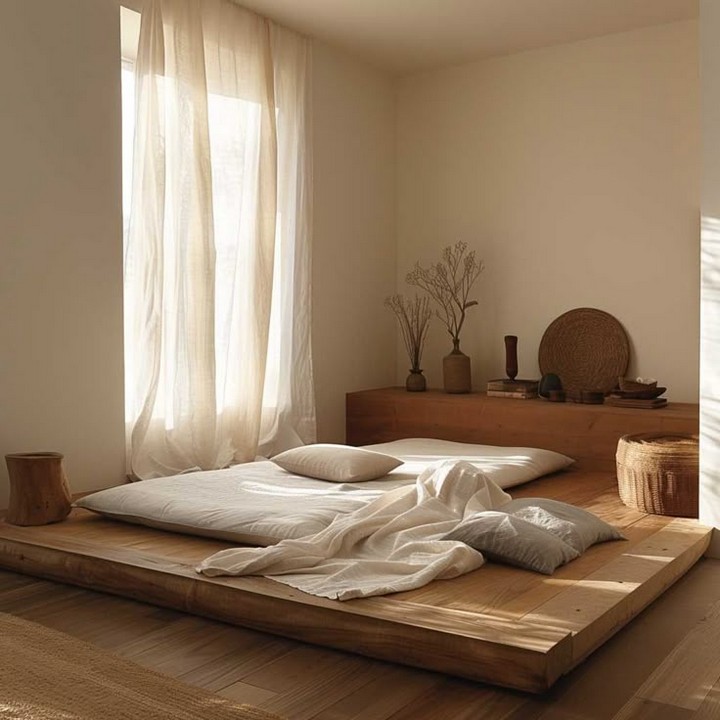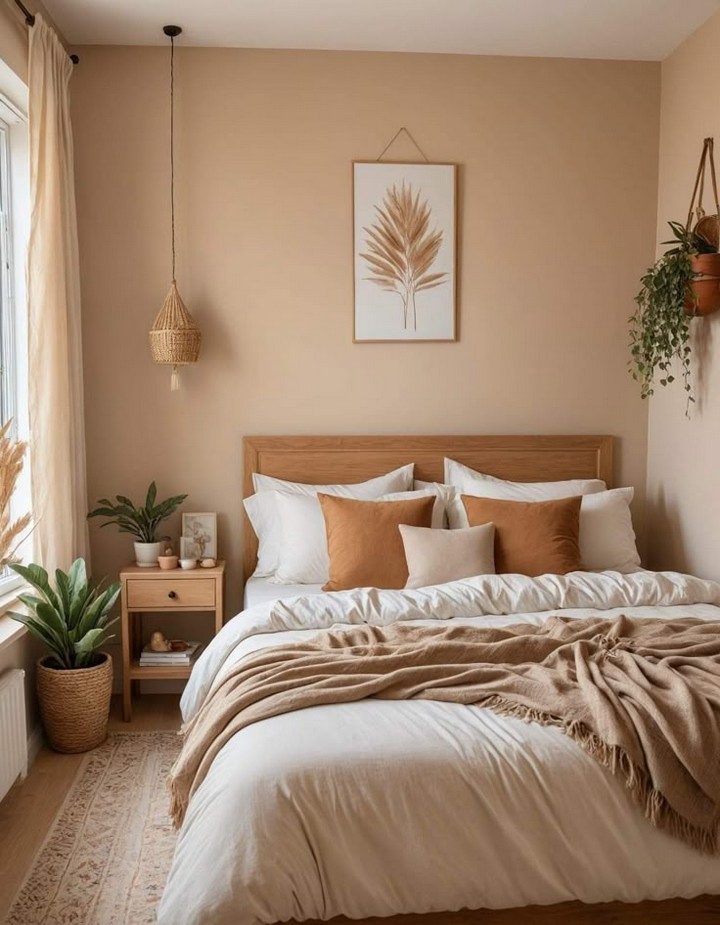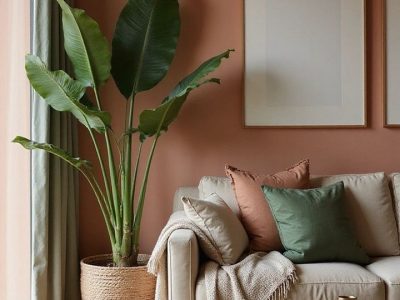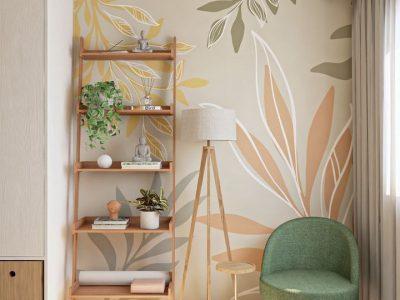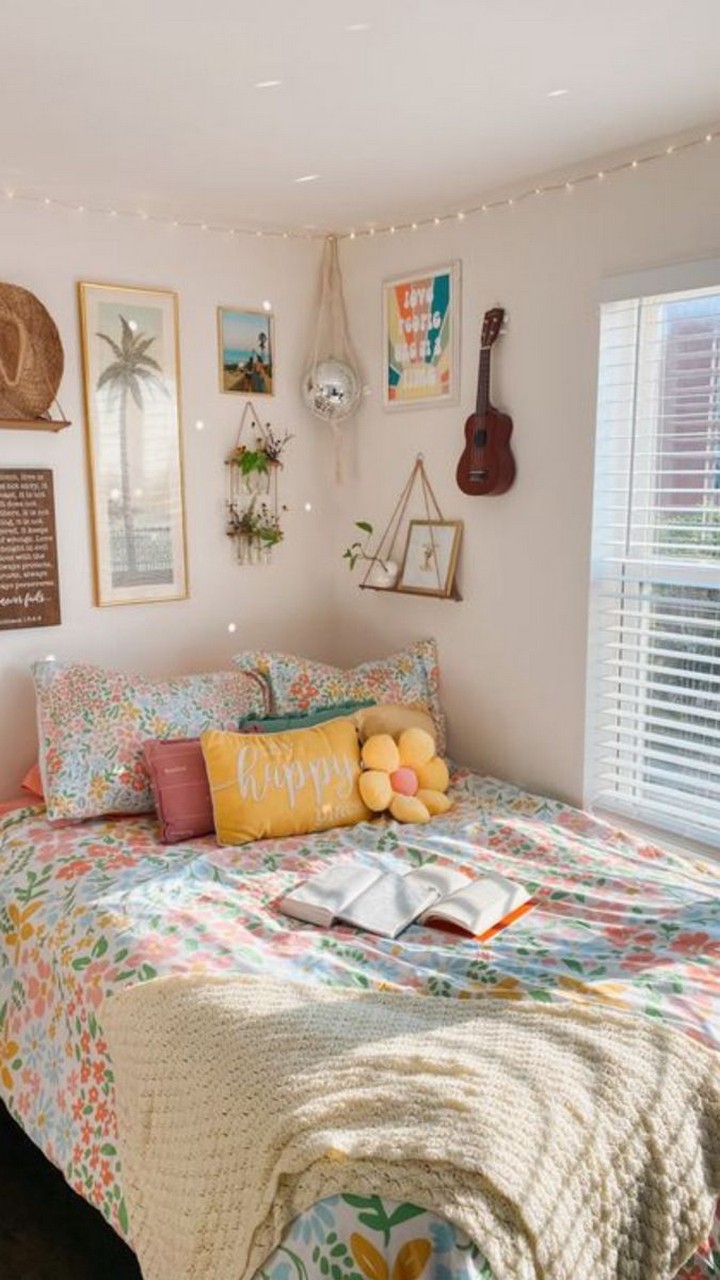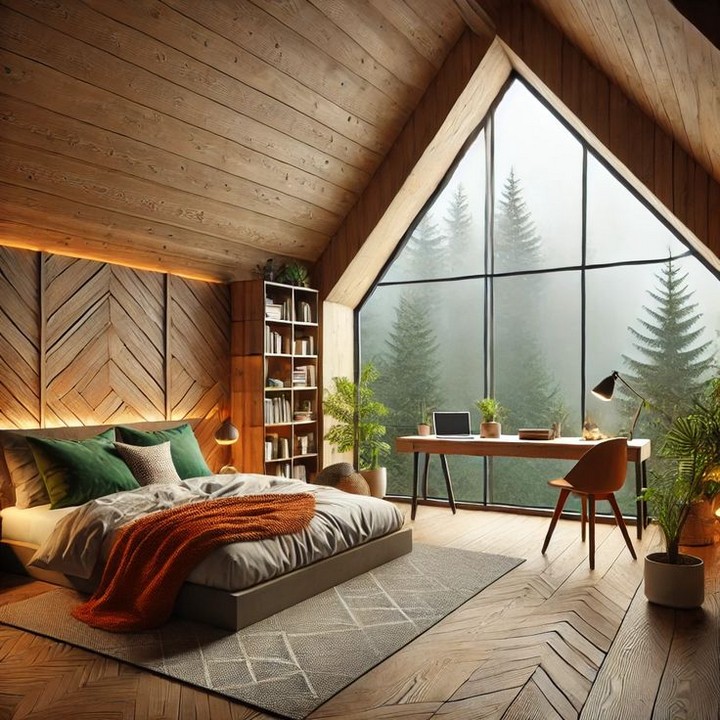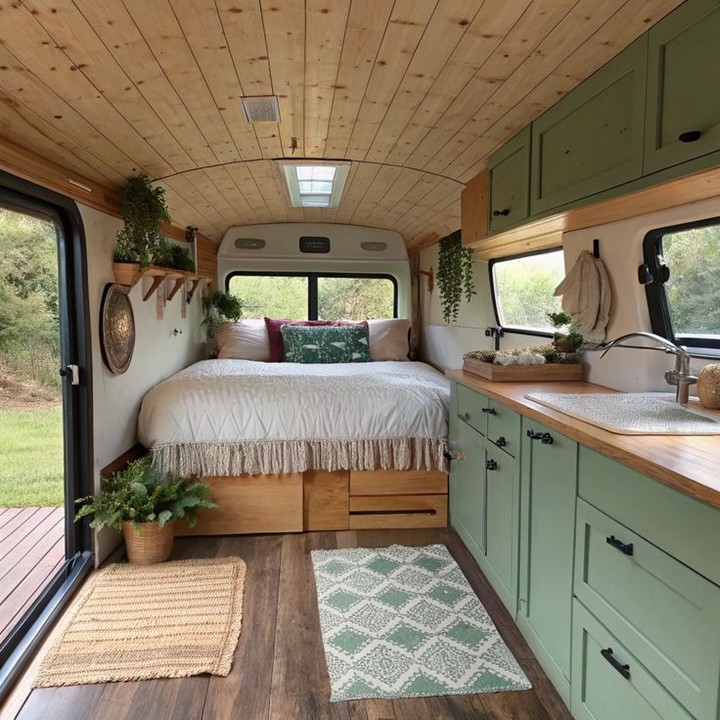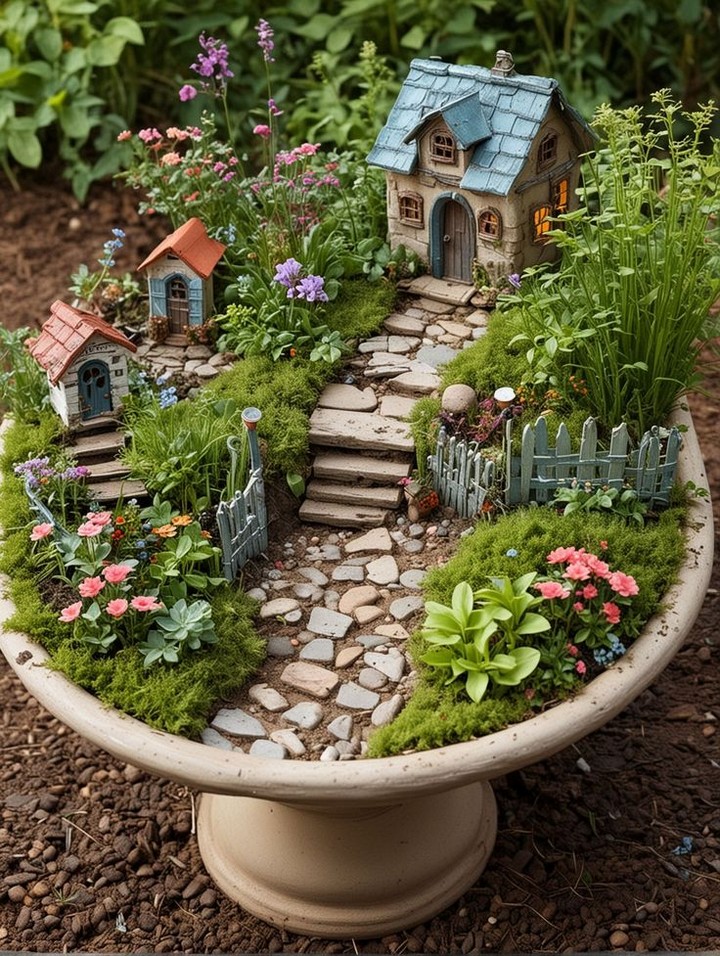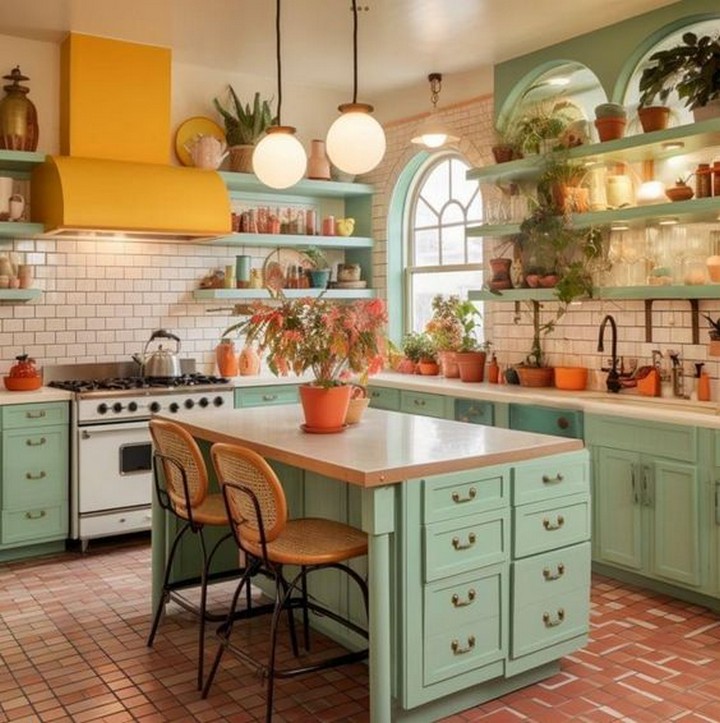Minimalist design is the go-to style for small bedrooms, offering a clutter-free, visually calm space while maximizing functionality. When paired with clever, space-saving furniture, even the tiniest bedroom can feel open, airy, and livable. Minimalist design has become a popular choice for small bedrooms. It emphasizes simplicity, functionality, and clean aesthetics while maximizing space efficiency.
In today’s urban living environments, where space comes at a premium, creating a functional yet stylish small bedroom presents both challenges and opportunities. Modern minimalist design principles offer the perfect solution for compact spaces, emphasizing clean lines, thoughtful organization, and multifunctional furniture that maximizes every square inch.
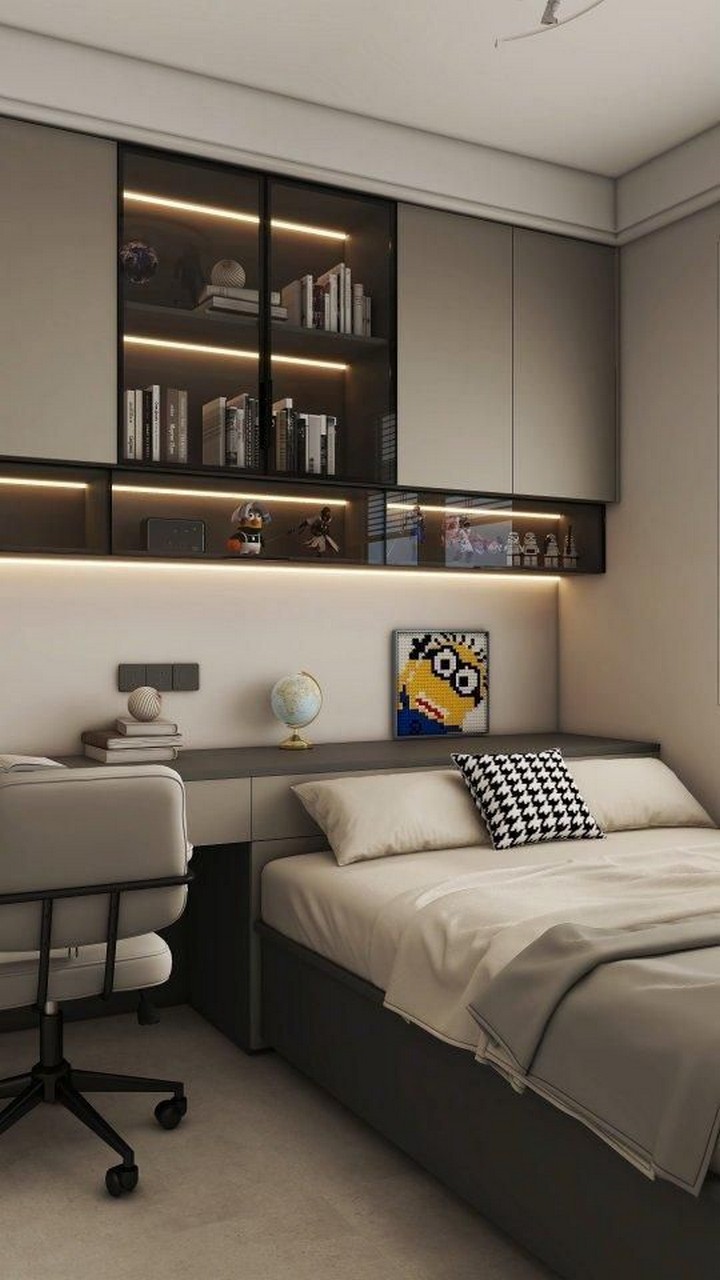
This comprehensive guide presents 34 innovative small bedroom ideas that blend minimalist aesthetics with space-saving furniture solutions. Whether you’re furnishing a studio apartment, designing a guest room, or maximizing a compact primary bedroom, these concepts will help transform your limited space into a serene, functional retreat.
Smart Bed Solutions for Small Spaces
1. Wall Beds (Murphy Beds) with Integrated Storage
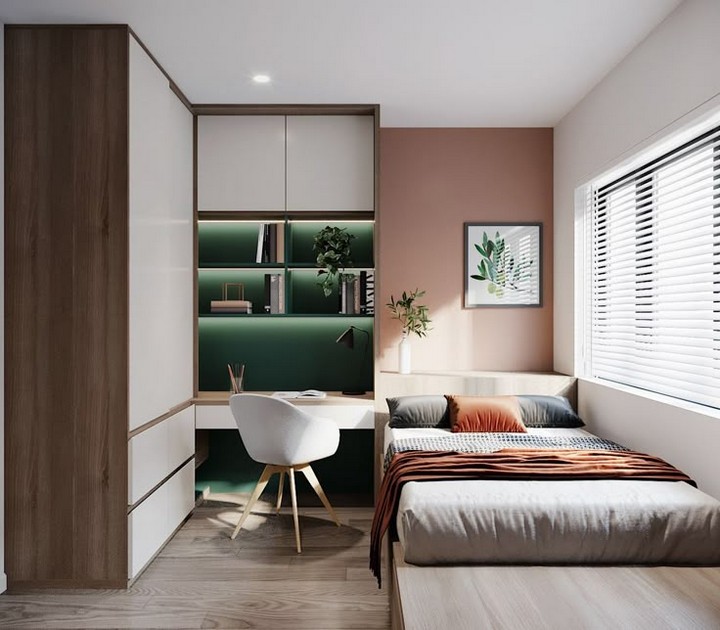
Wall beds have evolved significantly from their utilitarian origins. Today’s designs seamlessly integrate into modern minimalist interiors while offering remarkable functionality. When folded up, they provide valuable floor space for other activities; when down, they transform the room into a comfortable sleeping area. Many contemporary designs include built-in shelving, desks, or sofas that remain usable even when the bed is lowered.
Design tip: Choose models with hydraulic mechanisms for easy operation and slim profiles when closed to maintain the minimalist aesthetic.
2. Platform Beds with Underbed Storage
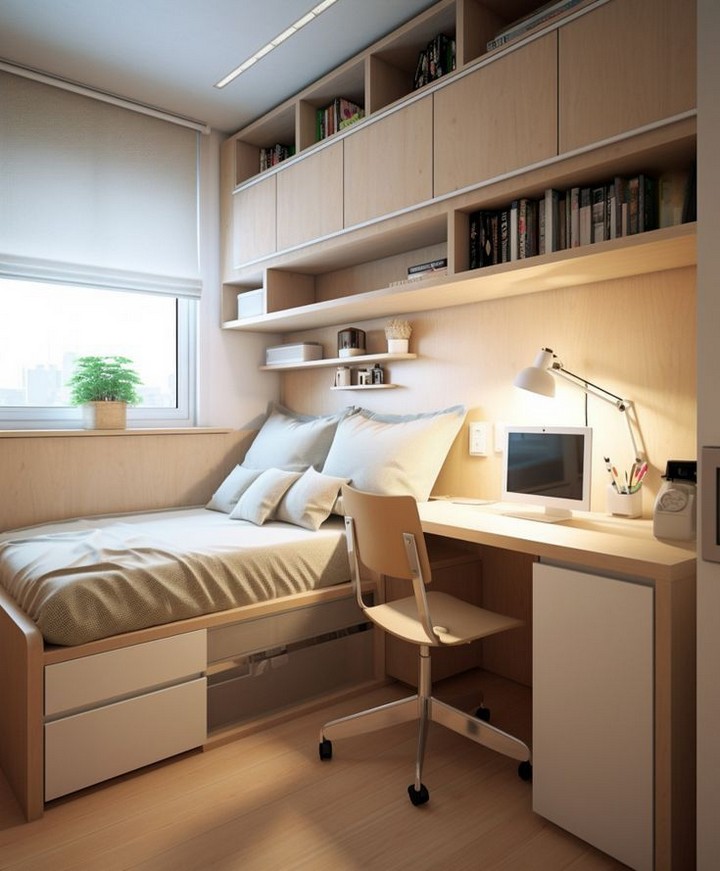
Platform beds eliminate the need for box springs while creating valuable storage opportunities underneath. Modern designs feature built-in drawers or lift-up mechanisms that reveal generous storage compartments. This approach maintains clean lines while significantly expanding your storage capacity.
Design tip: Select platforms with smooth, handleless drawer fronts for a sleeker, more minimalist look.
3. Loft Beds with Workspaces Below
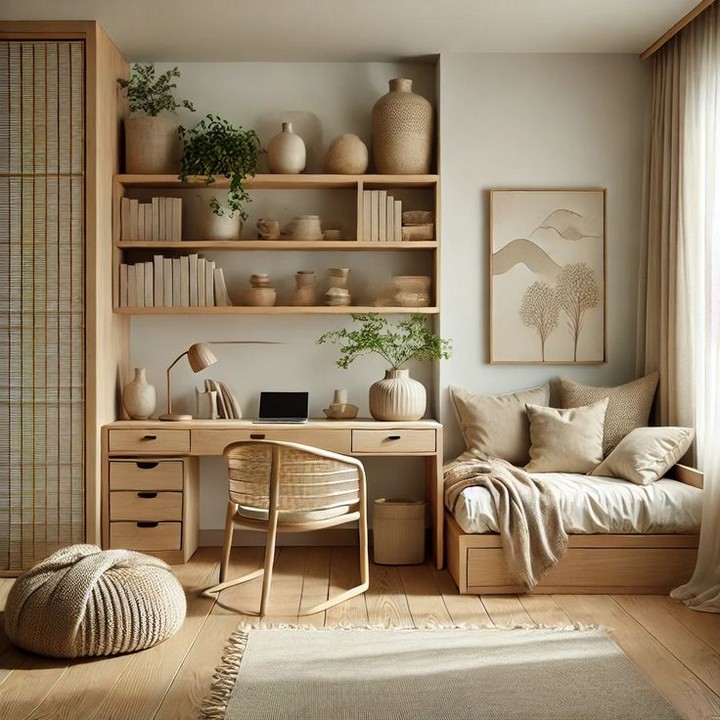
For particularly small rooms, vertical thinking becomes essential. Contemporary loft beds can create an entirely new functional zone beneath your sleeping area. Modern iterations feature sleek metal frames or minimalist wooden designs that support your mattress while freeing up the footprint below for a desk, seating area, or storage solutions.
Design tip: Choose loft beds with integrated ladders or stairs that include built-in storage to maximize functionality.
4. Convertible Sofa Beds
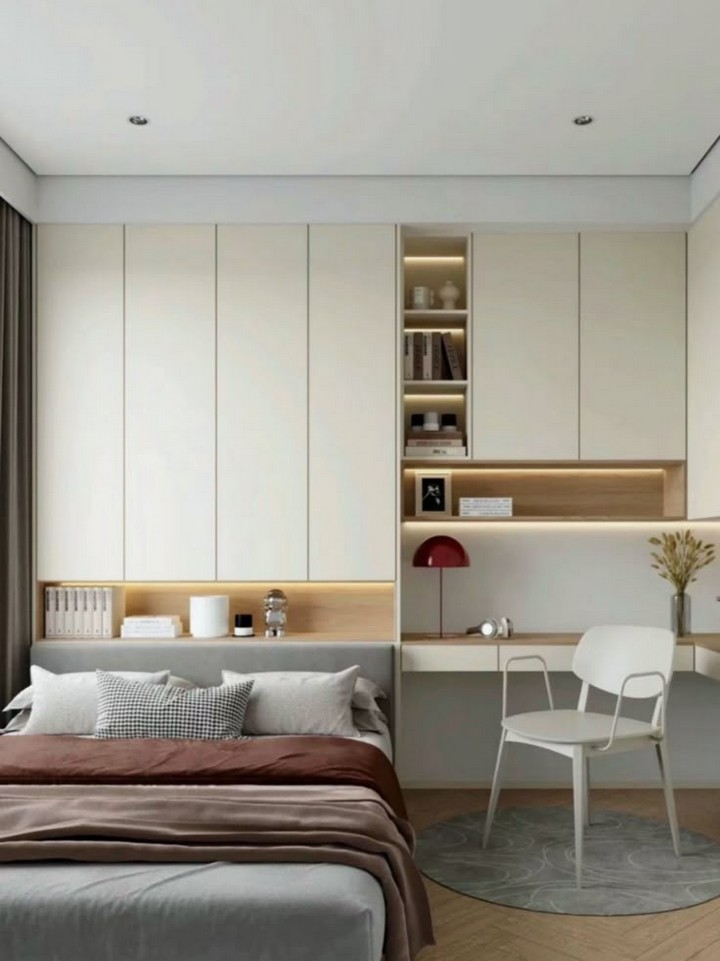
Today’s sofa beds bear little resemblance to their uncomfortable predecessors. Modern designs transform from stylish seating to comfortable beds with minimal effort. For studio apartments or multipurpose rooms, these dual-function pieces are invaluable.
Design tip: Look for click-clack mechanisms or pull-out designs that operate smoothly and don’t require removing cushions.
5. Adjustable Smart Beds
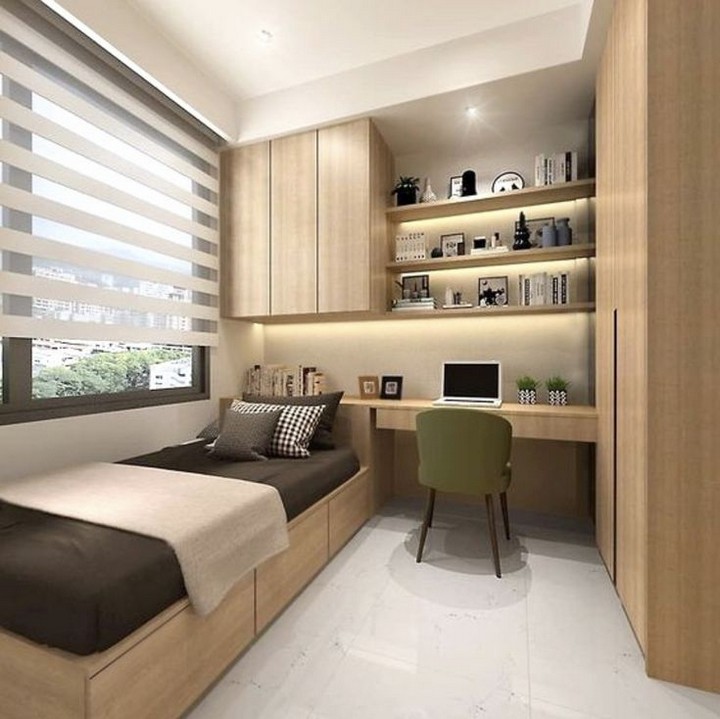
Technology meets minimalism with adjustable bed frames that adapt to different activities. These frames can shift from flat sleeping positions to sitting configurations for reading or laptop work, eliminating the need for additional furniture pieces.
Design tip: Choose models with minimal profiles and hidden mechanics to maintain clean lines.
6. Japanese-Inspired Floor Beds
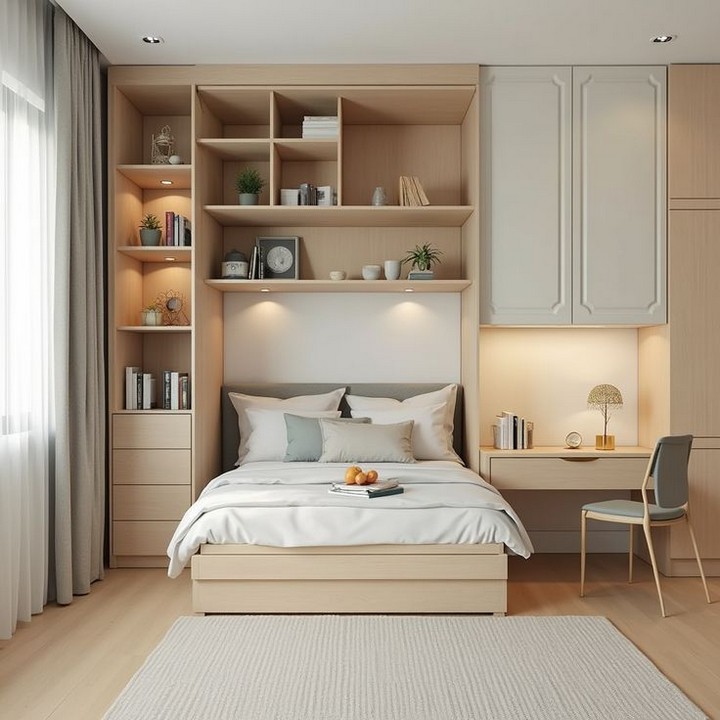
Embracing the minimalist principles of Japanese design, low-profile platform beds or floor futons create an airy, open feeling in small bedrooms. Without bulky frames or headboards, these sleeping solutions visually expand the space while maintaining comfort.
Design tip: Pair with low storage solutions like floor cushions with hidden compartments or sleek floating shelves.
Innovative Storage Solutions
7. Floor-to-Ceiling Customized Wardrobe Systems

Custom wardrobe systems that extend to the ceiling maximize vertical storage while maintaining a clean, built-in look. Modern designs feature handleless push-open mechanisms or recessed grips that eliminate visual interruptions.
Design tip: Choose sliding doors rather than hinged options to eliminate the need for door clearance space.
8. Headboards with Hidden Storage
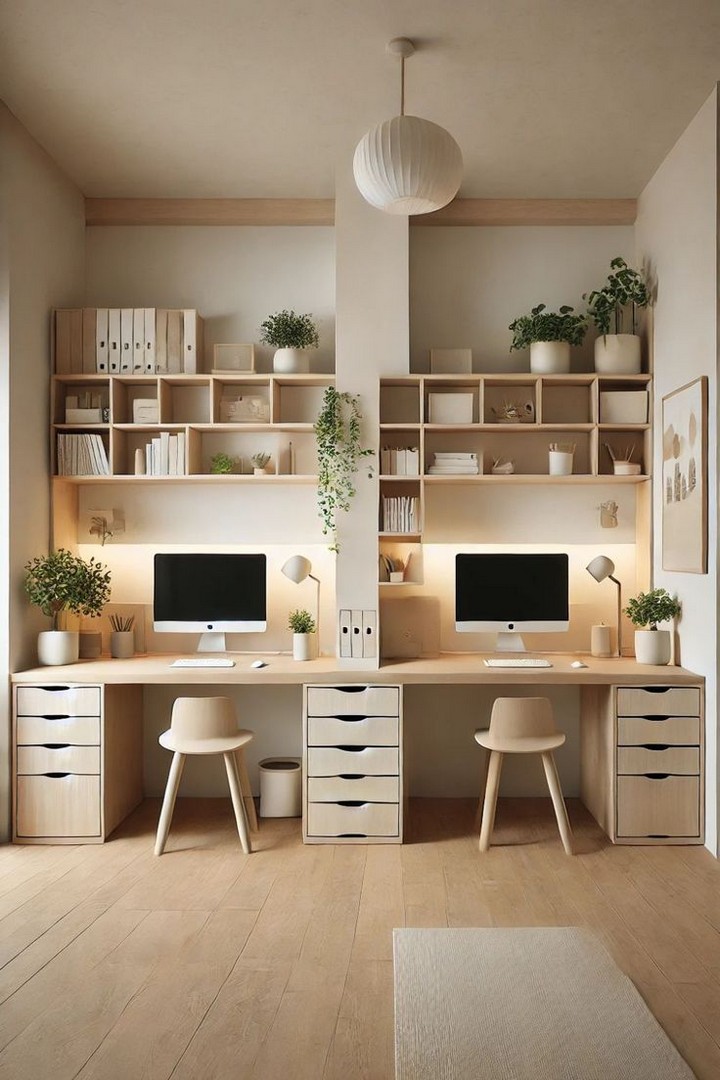
Multifunctional headboards can incorporate shelving, cabinets, or pull-out compartments without increasing the bed’s footprint. These clever solutions provide convenient storage for books, devices, and bedside essentials without requiring nightstands.
Design tip: Look for designs with built-in lighting to eliminate the need for table lamps.
9. Floating Nightstands
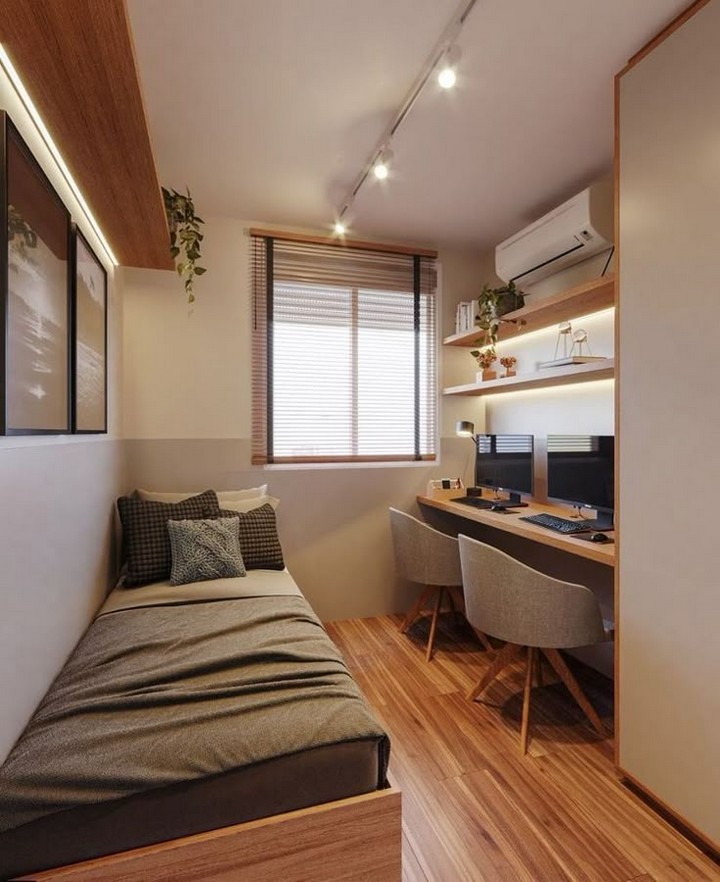
Wall-mounted bedside tables free up floor space while providing essential surface area for nighttime necessities. Modern minimalist designs feature slim profiles, often with a small drawer or compartment for items you’d prefer to keep out of sight.
Design tip: Position these at a height that creates visual continuity with your bed frame for a more cohesive look.
10. Pegboard or Grid Wall Systems
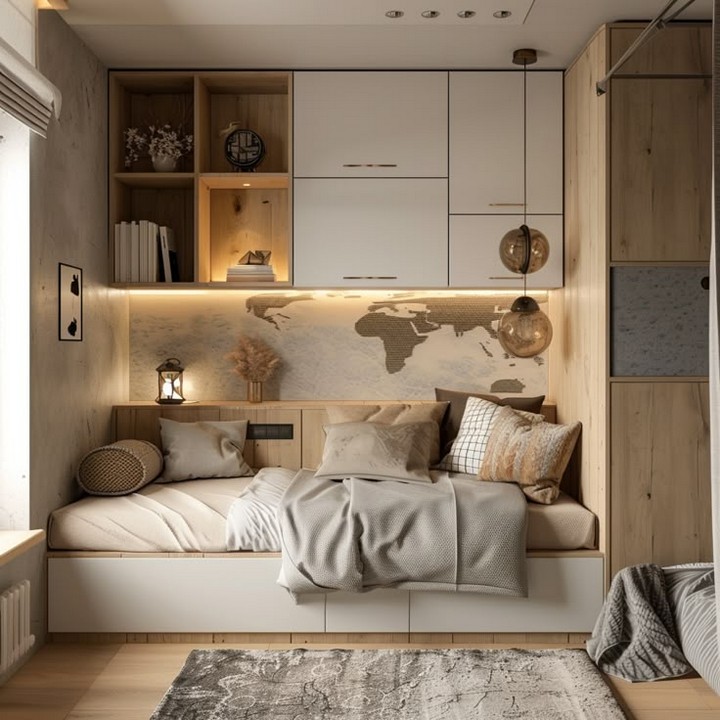
Customizable wall grids or pegboards offer flexible storage that can evolve with your needs. These systems support shelves, hooks, small containers, and even folding elements like desks or tables—all while maintaining a distinctly modern aesthetic.
Design tip: Choose versions in powder-coated metals or natural woods that complement your overall color scheme.
11. Behind-Door Storage Solutions
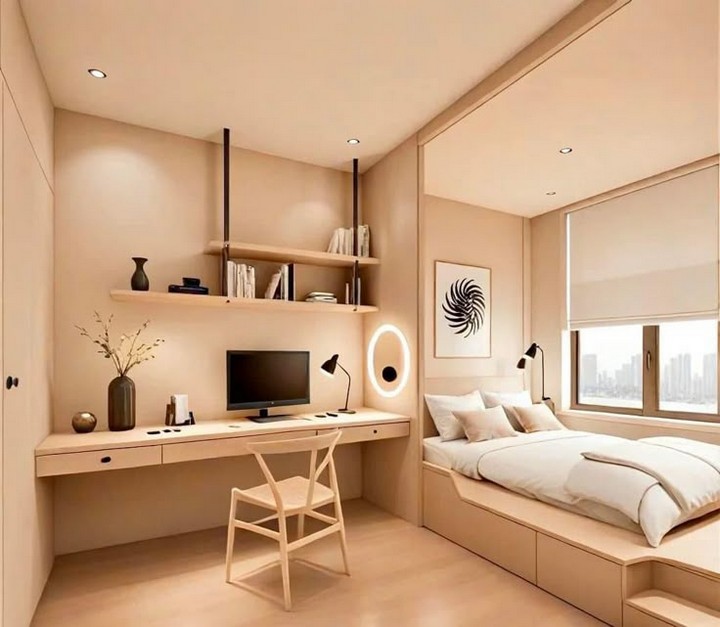
Modern behind-door organizers go well beyond basic hooks. Sleek designs can now hold jewelry, accessories, documents, or folded clothing items without creating visual clutter when the door is open.
Design tip: Look for slim-profile options that won’t prevent the door from closing properly.
12. Built-In Window Seating with Storage
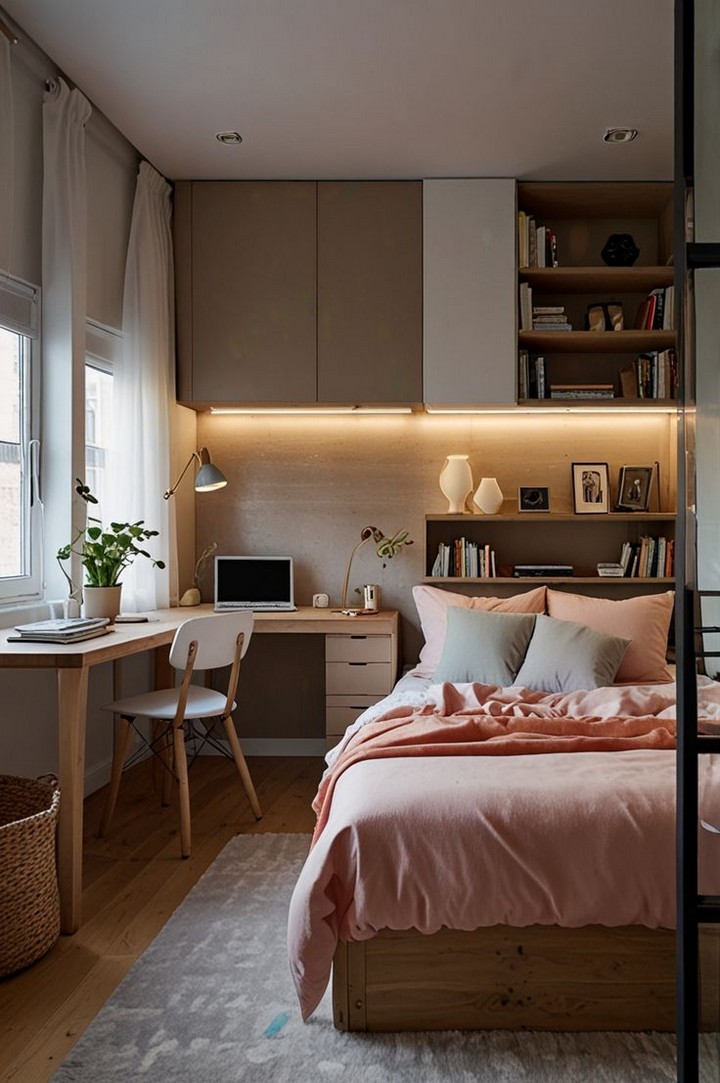
Window seats that incorporate drawers or lift-top storage create multifunctional space that serves as seating, storage, and a design feature. In minimalist designs, these elements often feature clean lines and discreet hardware.
Design tip: Top with a thin cushion in a neutral tone to maintain the minimalist aesthetic while adding comfort.
13. Hidden Compartment Furniture
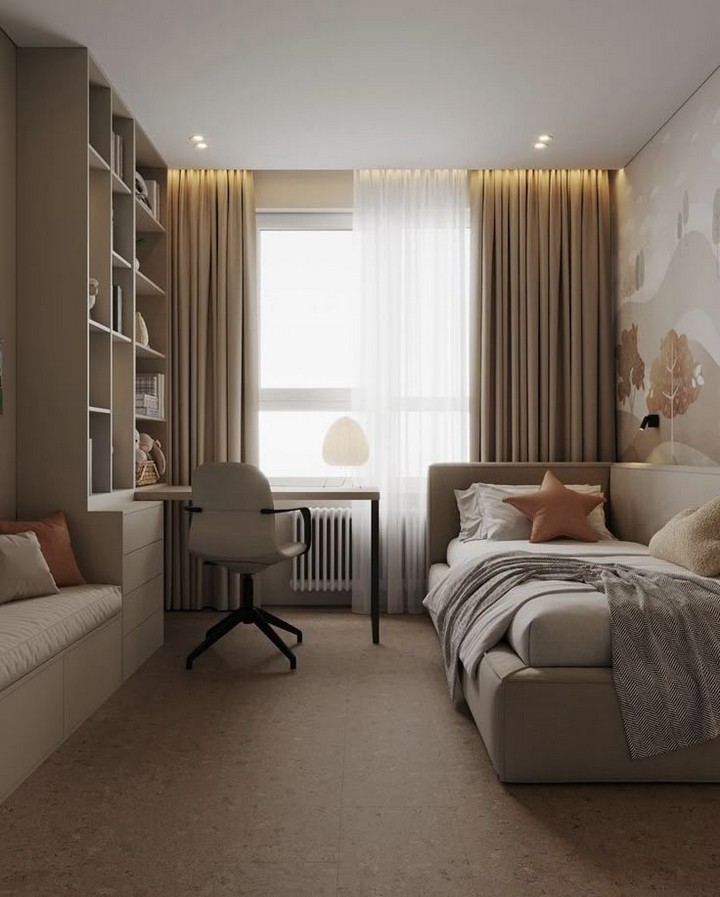
Contemporary minimalist furniture often incorporates unexpected storage in seemingly solid forms. Look for bed frames with hidden drawers in the headboard, ottomans with removable tops, or side tables with secret compartments.
Design tip: These hidden elements work best when the exterior design remains simple and uncluttered.
Space-Maximizing Furniture Arrangements
14. Corner Bed Placement
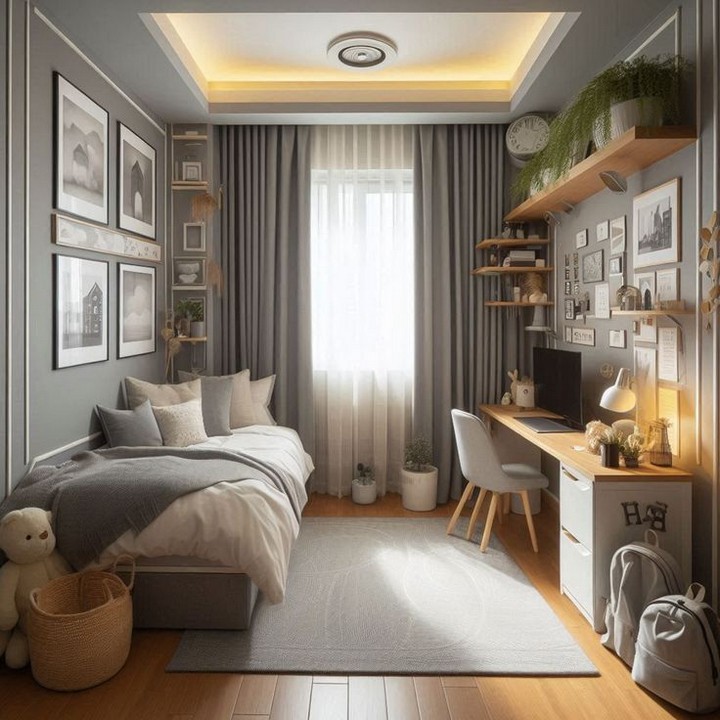
Rather than the traditional bed-against-wall arrangement, positioning your bed in a corner creates a cozy sleeping nook while potentially opening up more usable floor space in the rest of the room.
Design tip: Use corner-specific headboards or wall-mounted cushions to create a finished look.
15. Room-Dividing Furniture Systems
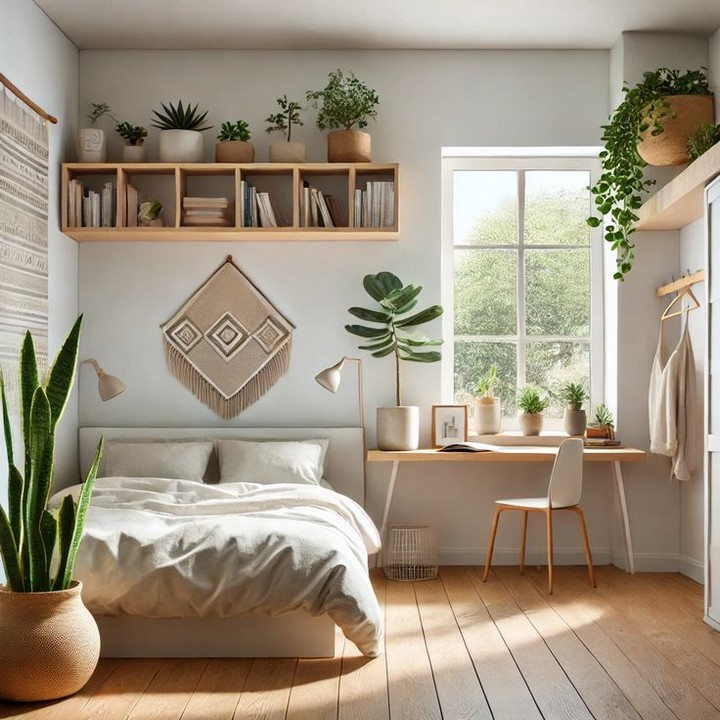
In studio apartments or shared bedrooms, low shelving units or partial walls can delineate the sleeping area while providing storage and maintaining an open feel. Modern systems often feature modular components that can be reconfigured as needed.
Design tip: Choose units with open backs to maintain light flow throughout the space.
16. Nested or Stackable Furniture
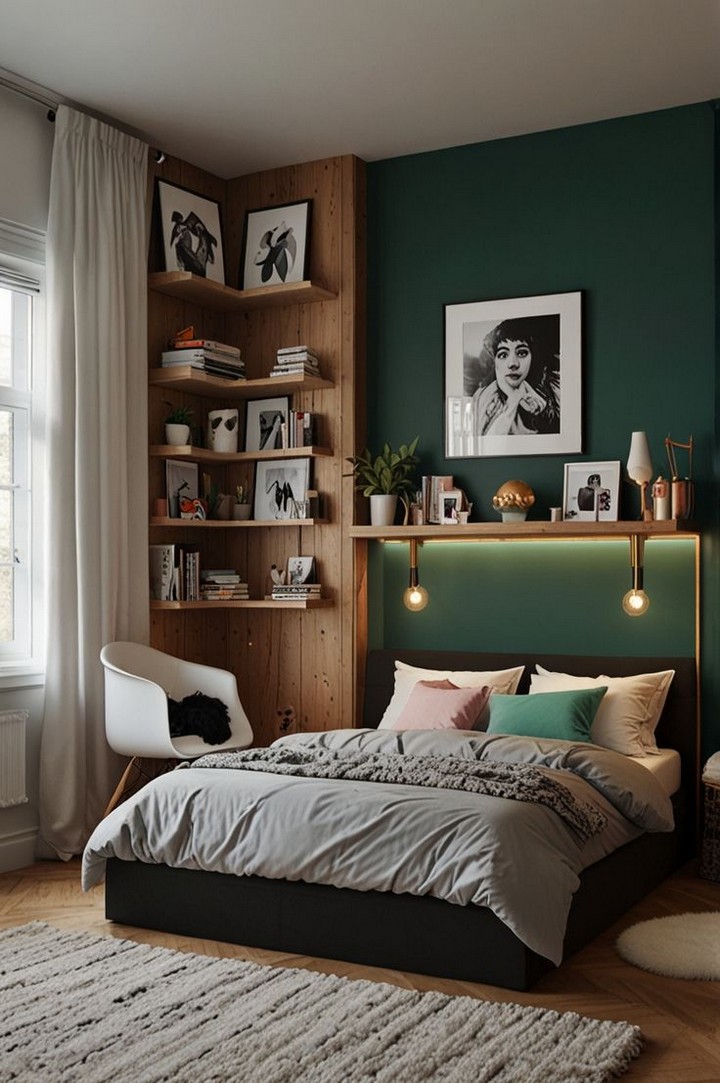
Tables, stools, or storage cubes that nest together when not in use provide flexibility without consuming valuable floor space. Contemporary designs often feature clean lines and complementary finishes that look intentional rather than makeshift.
Design tip: Look for pieces in graduated sizes that can serve multiple functions individually and as a set.
17. Wall-Mounted Desks with Fold-Down Tops
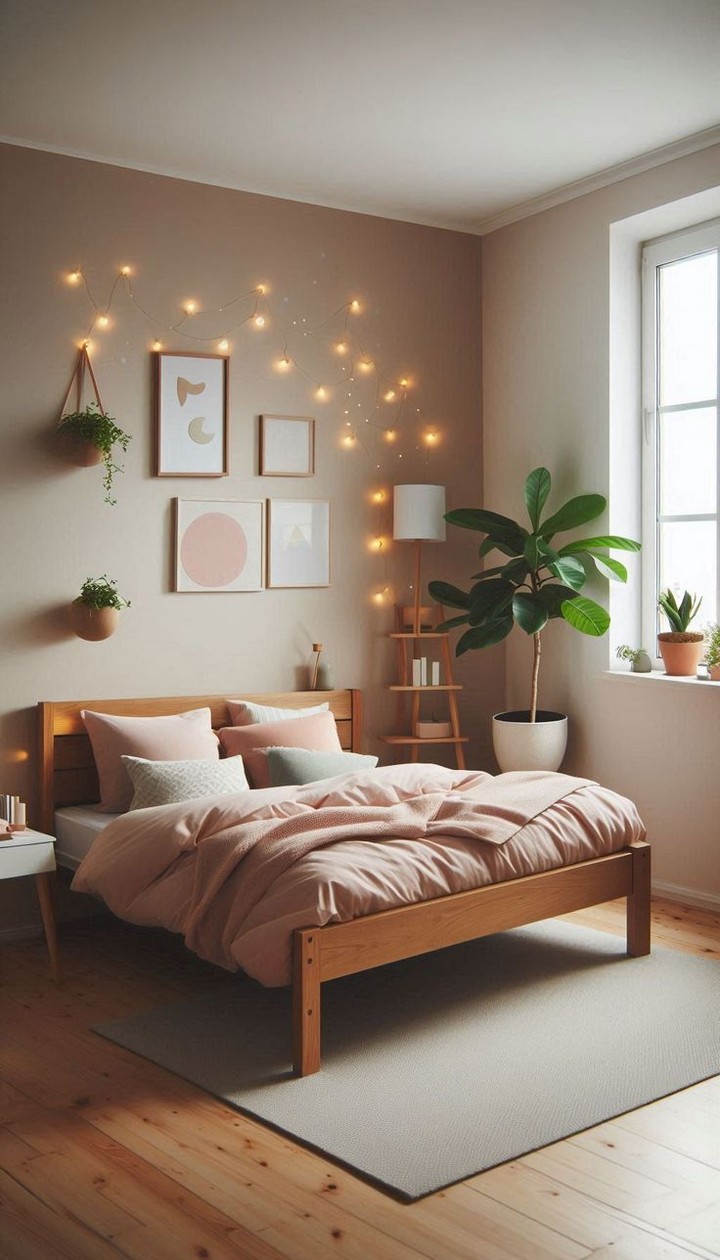
Desks that mount to the wall and fold away when not in use provide essential workspace without dedicating permanent floor area to this function. Modern designs often incorporate storage compartments that remain accessible even when the desk surface is folded up.
Design tip: Choose models with cable management solutions to prevent technological clutter.
18. Sliding Panel Room Dividers
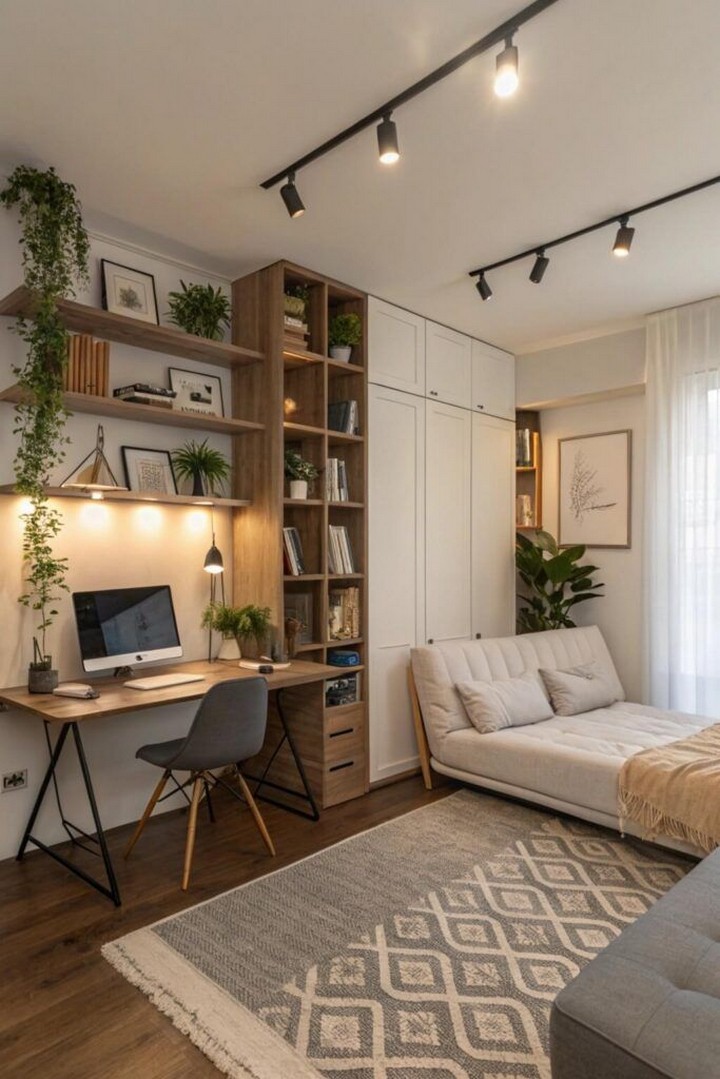
For more privacy in open-plan spaces, sliding panels offer a flexible solution that consumes less space than traditional doors or fixed walls. Contemporary designs range from frosted glass to wooden slats that filter light while defining separate zones.
Design tip: Mount tracks on the ceiling only (without floor tracks) for a cleaner look and easier movement through the space.
19. Modular Shelving Systems
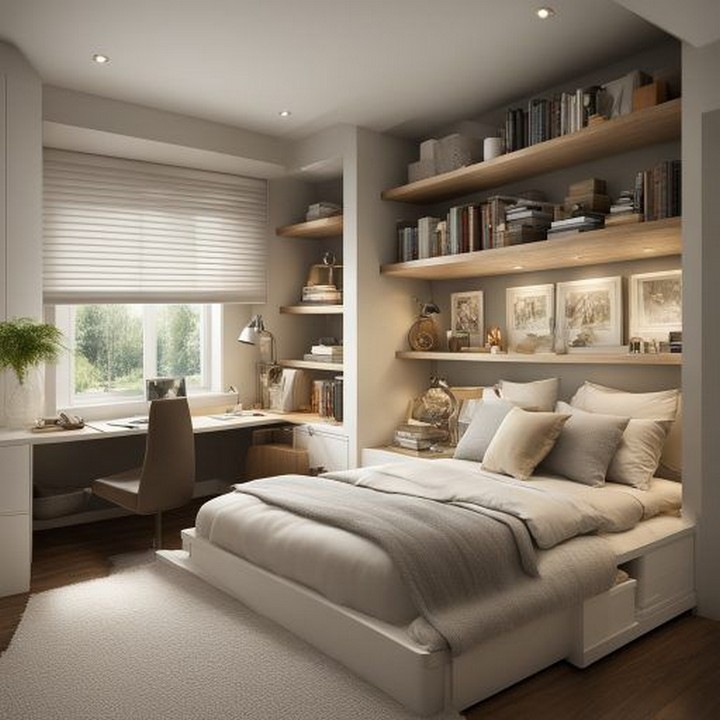
Adaptable shelving units that can be reconfigured as your needs change are ideal for small spaces. Look for systems with components that can function as desks, display areas, or storage depending on your current requirements.
Design tip: Choose systems with a mix of open shelving and closed storage to display decorative items while concealing necessities.
20. Ceiling-Mounted Clothing Racks
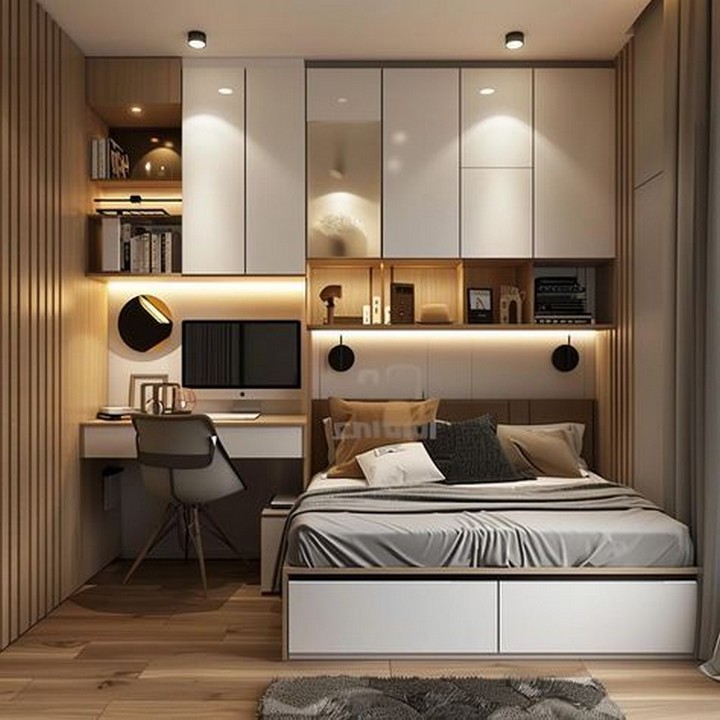
For bedrooms with limited closet space, minimal ceiling-mounted clothing rails provide storage without the bulk of traditional wardrobes. These can be particularly effective in rooms with high ceilings.
Design tip: Use slim, uniform hangers and organize clothing by color for a more intentional, less cluttered appearance.
Smart Lighting and Visual Expansion Techniques
21. Integrated LED Lighting Systems
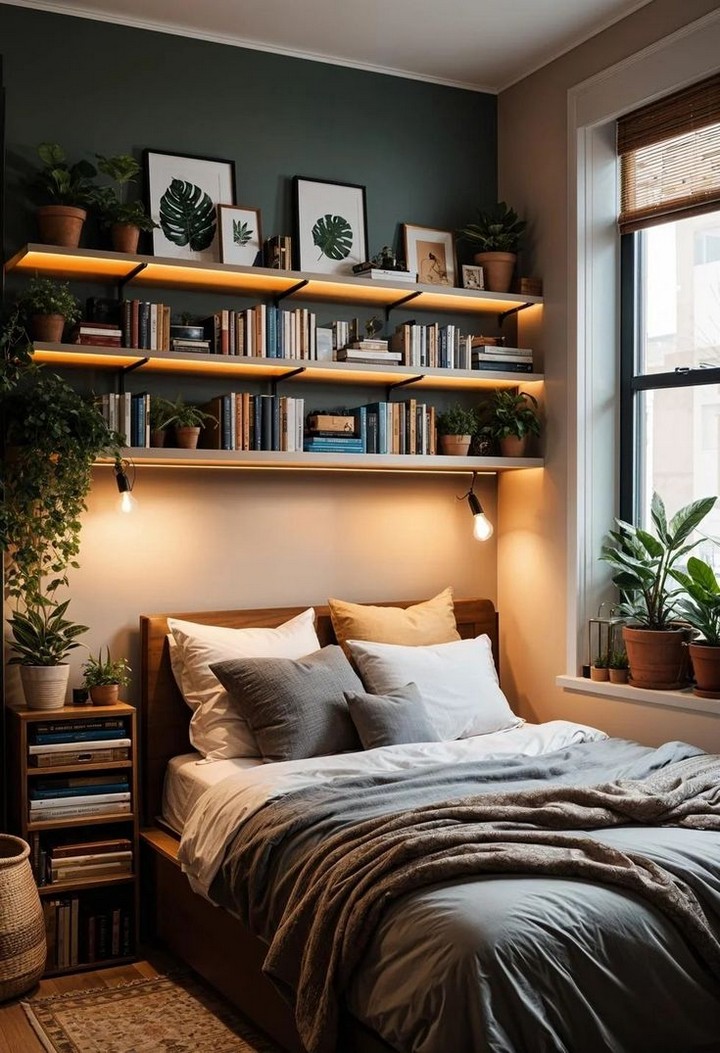
Built-in lighting that eliminates the need for floor or table lamps can significantly reduce visual clutter. Modern options include recessed ceiling lights, track systems, or LED strips integrated into furniture or architectural elements.
Design tip: Choose systems with dimming capabilities to adjust the mood and apparent size of the room throughout the day.
22. Transparent or Reflective Furniture Elements
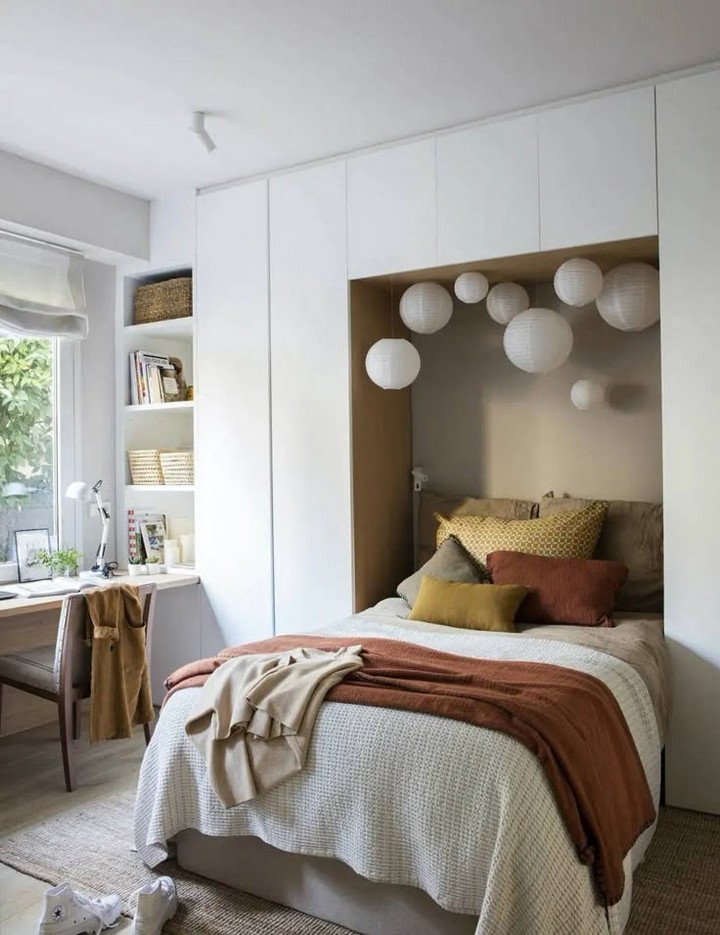
Furniture with glass, lucite, or reflective components visually disappears in a small space. Consider glass-topped desks, acrylic chairs, or mirrored cabinet fronts to maintain functionality without visual weight.
Design tip: Limit these elements to a few key pieces to prevent a busy appearance.
23. Strategic Mirror Placement
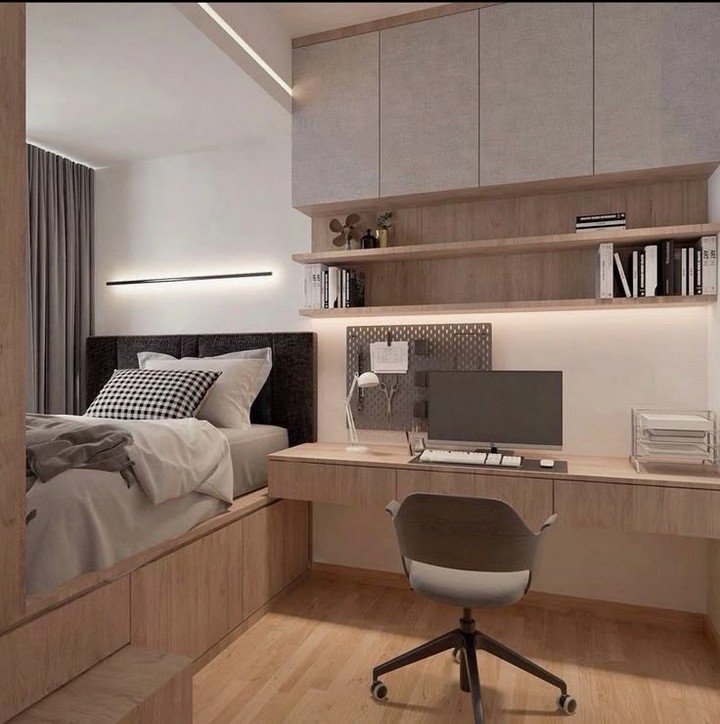
Beyond the basic wall mirror, consider mirrored furniture panels, ceiling insets, or room dividers to bounce light and visually expand the space. Contemporary designs often feature frameless edges or minimal frames in coordinating metals.
Design tip: Position mirrors to reflect natural light sources or attractive views for maximum impact.
24. Monochromatic Color Schemes
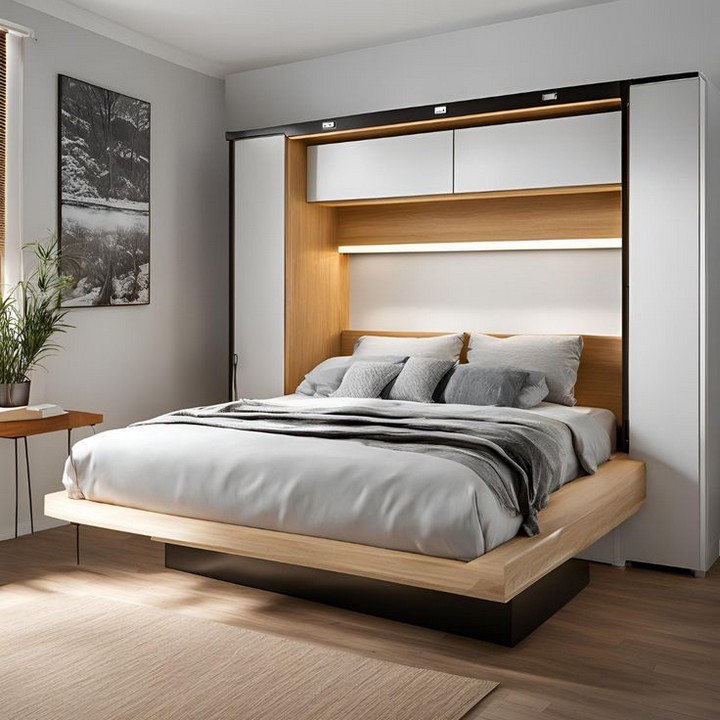
A limited color palette creates visual continuity that makes small spaces feel larger and more cohesive. Modern minimalist bedrooms often feature tone-on-tone neutral schemes with subtle texture variations for interest.
Design tip: Use different shades of the same color family rather than stark contrasts to create depth without division.
Technological Integration for Enhanced Functionality
25. Smart Home Hub Furniture
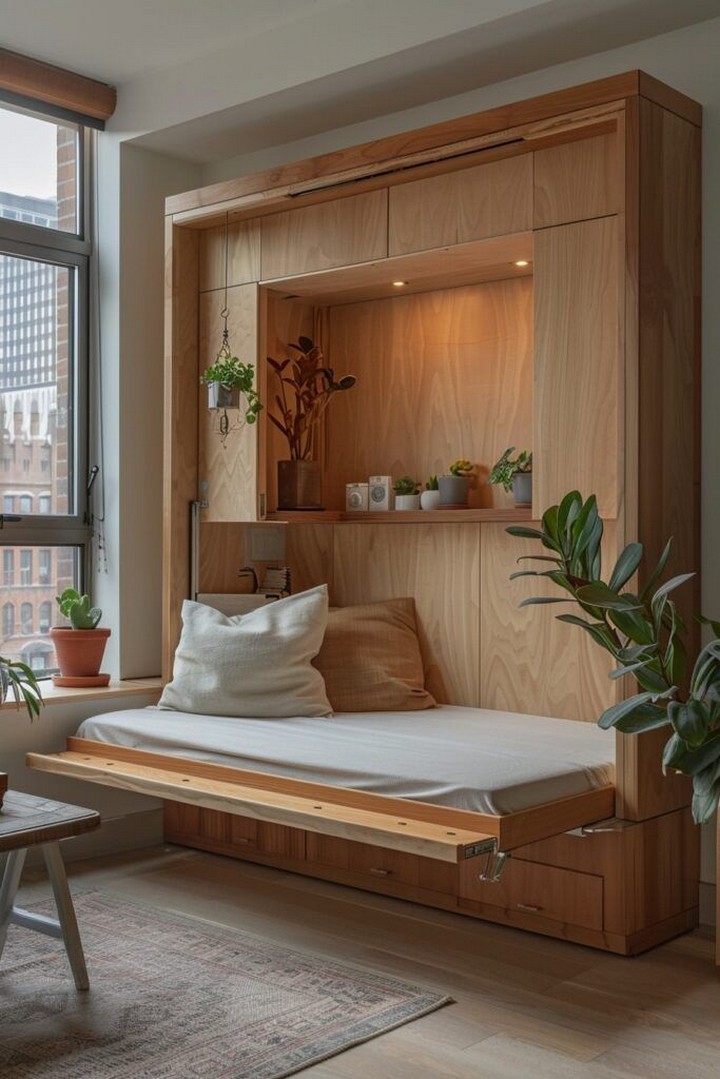
Furniture with integrated charging stations, speakers, or smart home controls eliminates the need for separate technological elements. Look for nightstands with wireless charging surfaces, headboards with built-in speakers, or bed frames with automated storage access.
Design tip: Choose designs where the technology is seamlessly integrated rather than visibly added on.
26. Projector Systems Instead of TVs
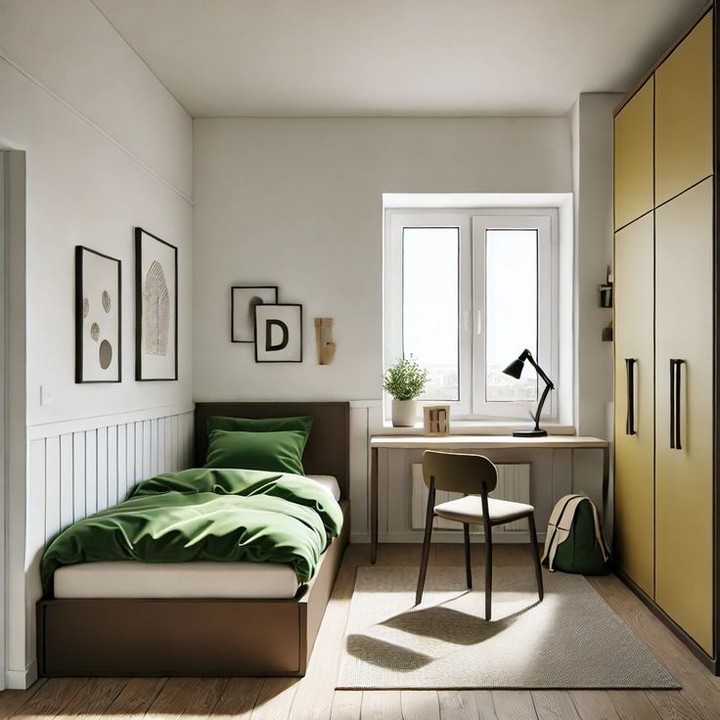
Rather than dedicating wall space and visual attention to a television, consider ceiling-mounted projector systems that can display on blank walls when desired and disappear when not in use.
Design tip: Pair with motorized screens or projector lifts that conceal the equipment when not in use.
27. App-Controlled Transforming Furniture
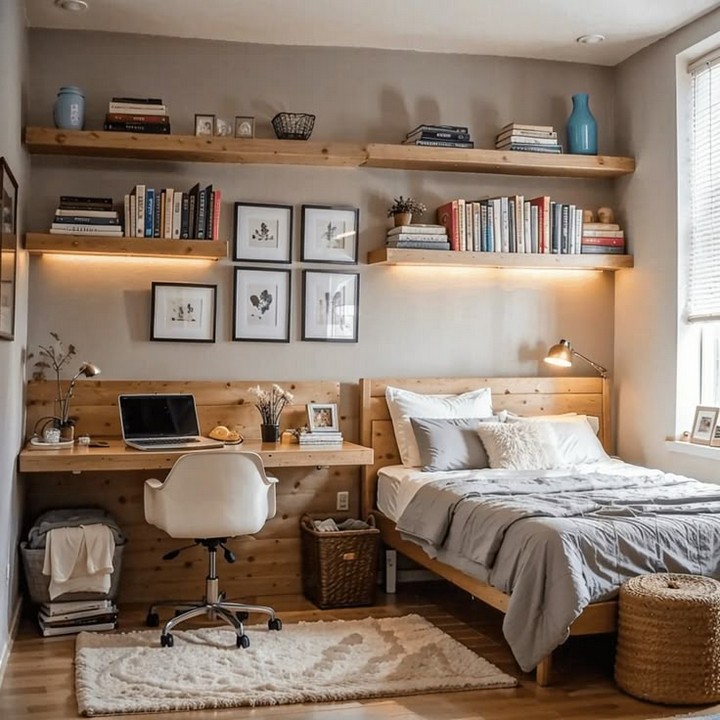
The cutting edge of space-saving design includes furniture that transforms via smartphone controls. From beds that lower from the ceiling to desks that unfold from wall panels, these high-tech solutions maximize functionality while maintaining minimalist aesthetics.
Design tip: Look for systems with manual override options in case of power or connectivity issues.
28. Hidden Outlets and Charging Solutions
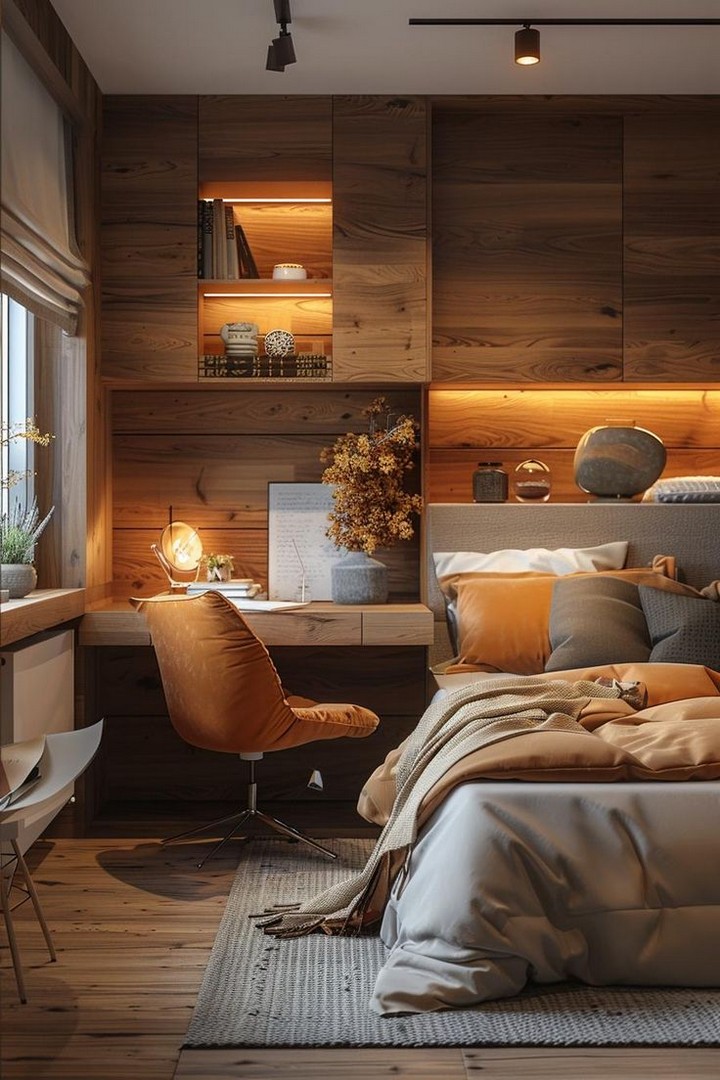
Maintain clean lines with power solutions integrated into furniture or architectural elements. Modern options include pop-up outlet towers in nightstands, USB ports built into headboards, or wireless charging pads embedded in surfaces.
Design tip: Plan your furniture arrangement around existing outlet locations to minimize visible cords.
Minimalist Décor and Finishing Touches
29. Wall-Mounted Plants or Vertical Gardens
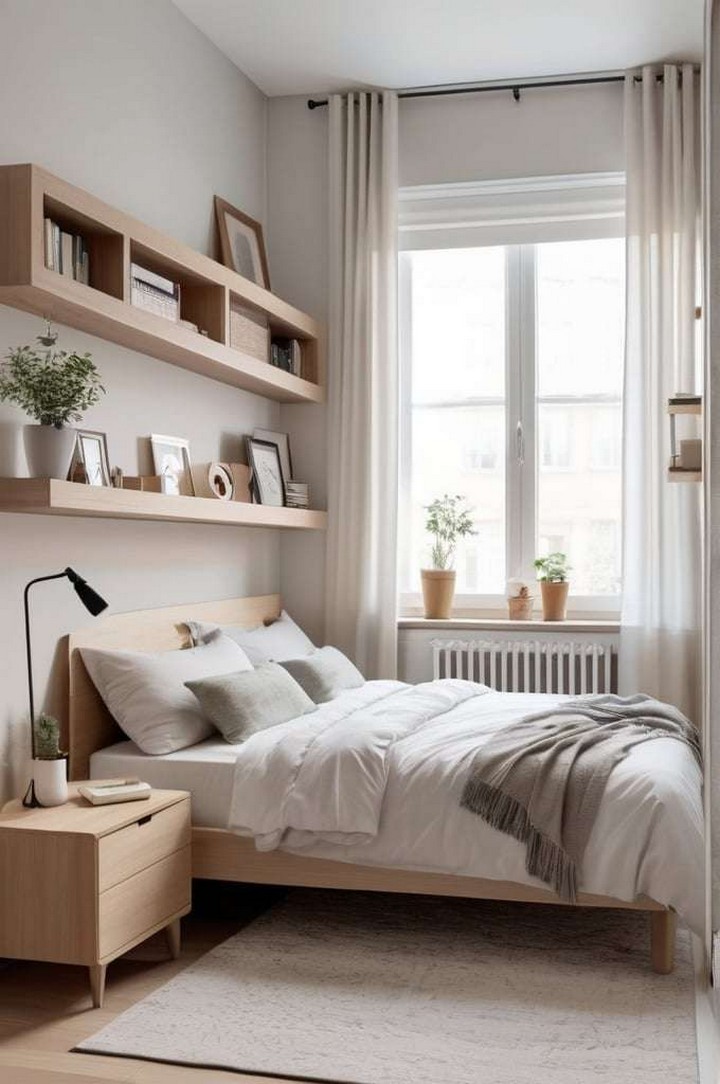
Bring nature into your small bedroom without sacrificing floor space by installing wall-mounted planters or vertical garden systems. Modern options include magnetic pots, modular wall panels, or hanging systems that add life without bulk.
Design tip: Choose low-maintenance plants with architectural forms that complement your minimalist aesthetic.
30. Acoustic Wall Panels
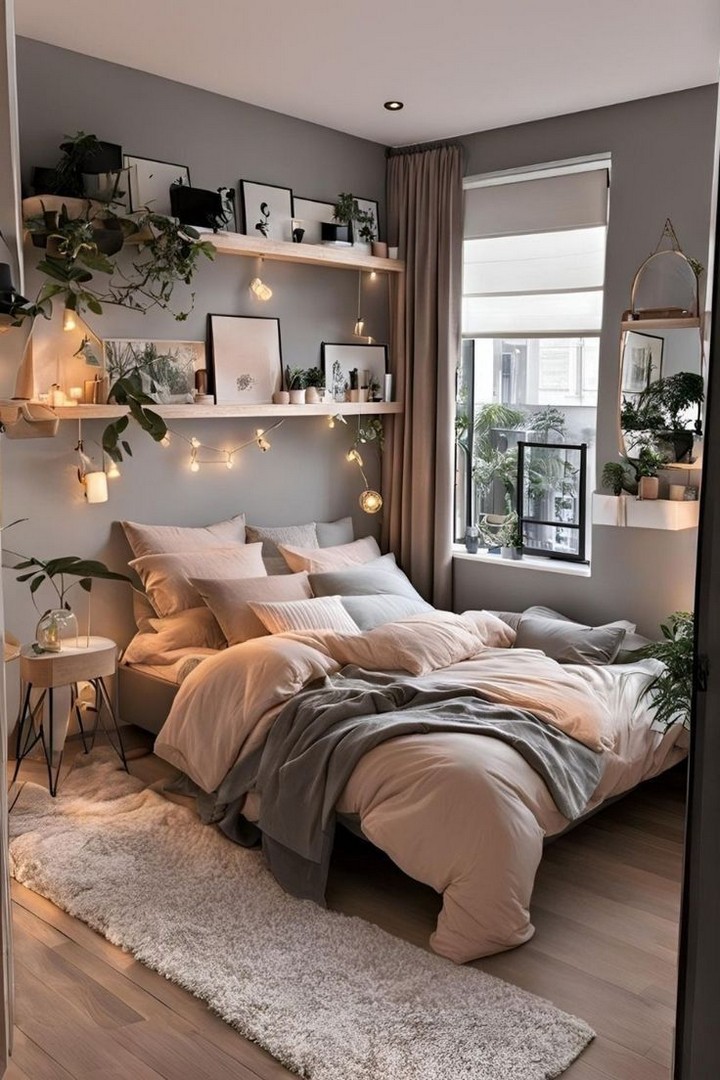
Dual-purpose wall treatments that provide sound absorption while serving as artistic elements can enhance comfort without adding clutter. Contemporary designs feature geometric patterns, textural variations, or subtle color shifts that add interest without overwhelming.
Design tip: Look for panels that can be rearranged periodically to refresh your space without new purchases.
31. Ceiling-Mounted Curtain Systems
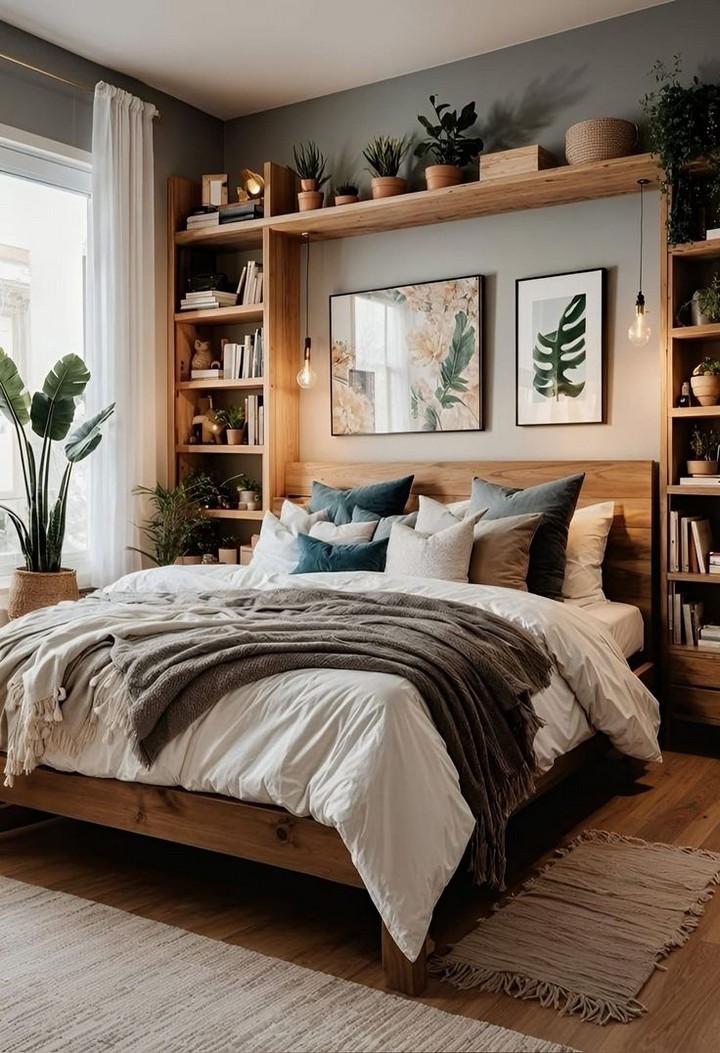
Free up wall space by mounting curtain tracks to the ceiling rather than using traditional rods and hardware. This approach creates cleaner lines while potentially allowing curtains to be drawn around the bed for privacy or light control.
Design tip: Choose fabrics with enough weight to hang properly from ceiling height without excessive bunching.
32. Minimalist Hardware Solutions

Replace conventional cabinet pulls, doorknobs, and hooks with streamlined alternatives like recessed grips, magnetic closures, or push-latch mechanisms. These small changes can significantly reduce visual noise in a compact space.
Design tip: When visible hardware is necessary, choose options that blend with adjacent surfaces rather than creating contrast.
33. Floating Shelves with Hidden Mounts
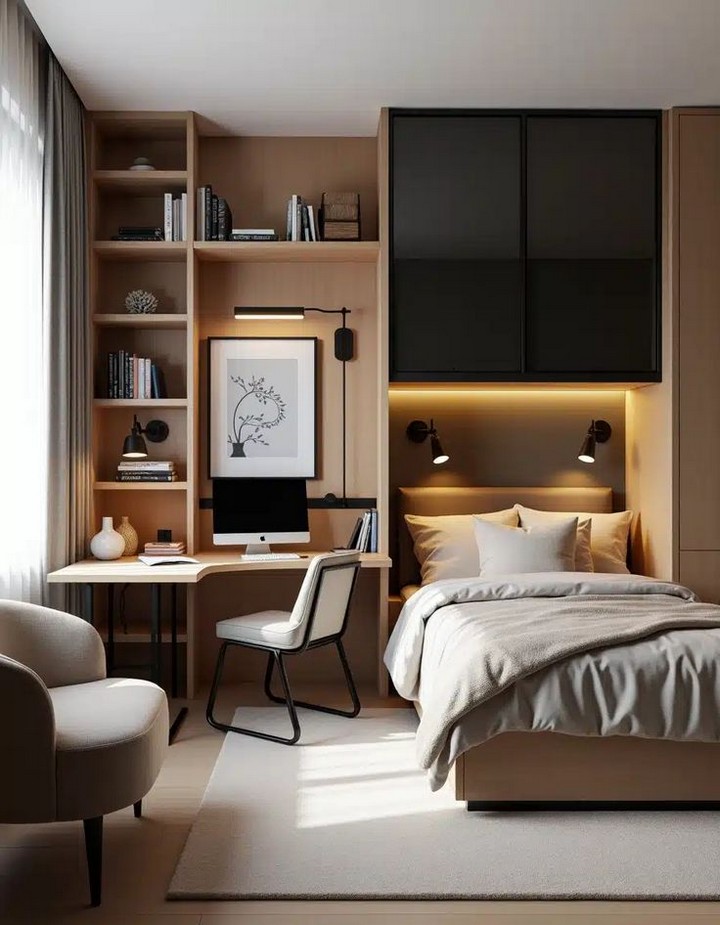
Display essential items or decorative pieces on slim shelves with concealed mounting hardware. Contemporary designs achieve the appearance of shelves that emerge directly from the wall, maintaining clean lines throughout the room.
Design tip: Arrange objects with ample negative space between them to preserve the minimalist feeling.
34. Digital Art Displays
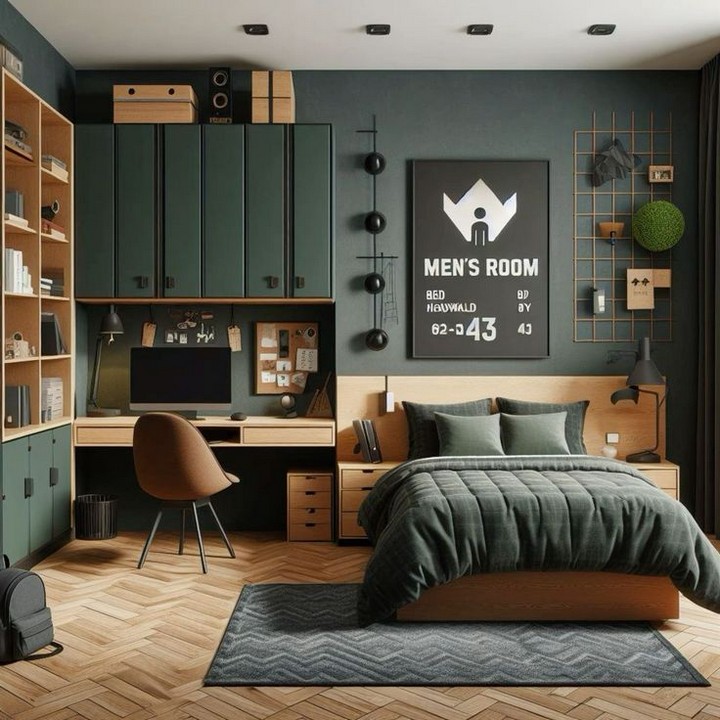
Replace multiple art pieces or photographs with digital display frames that can showcase rotating collections. This approach provides visual interest and personalization without physical clutter.
Design tip: Choose frames with matte, non-reflective screens and automatic dimming features for a more integrated look.
Implementing Your Minimalist Small Bedroom Vision
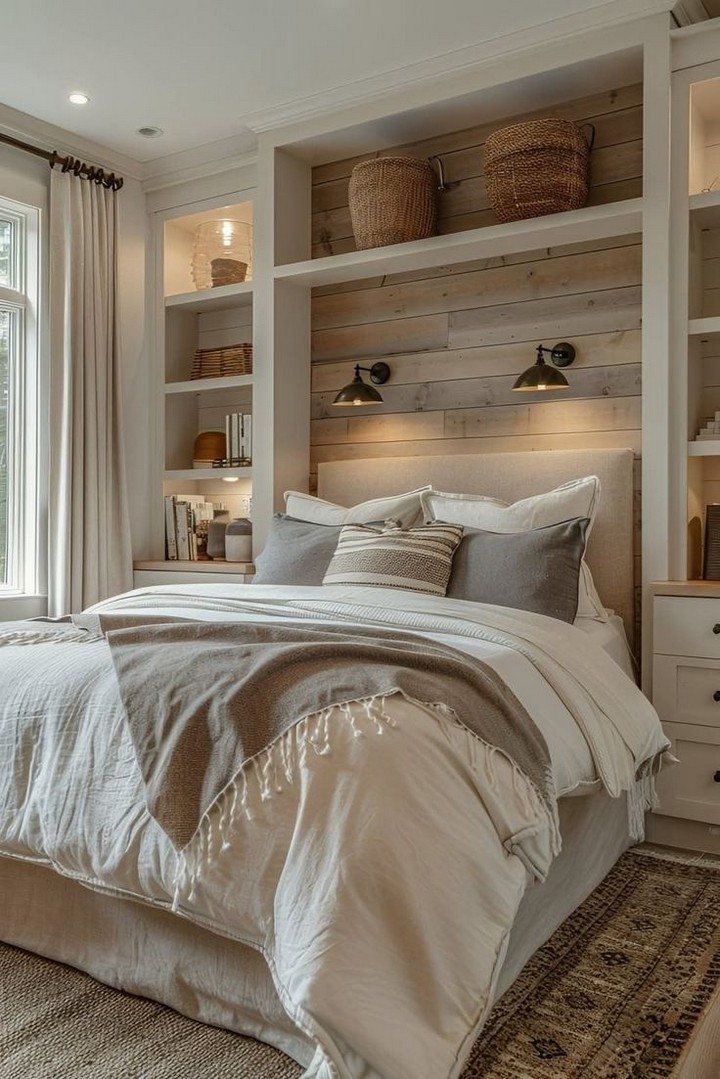
Creating a successful minimalist small bedroom requires thoughtful planning and selective purchasing. Before investing in new furniture or accessories:
- Assess your true space requirements by measuring your room dimensions and mapping out different furniture arrangements
- Identify your essential functions beyond sleeping do you need workspace, exercise area, or storage for specific collections?
- Consider your movement patterns to ensure furniture placement supports natural flow through the space
- Create a cohesive design concept with a consistent color palette and complementary materials
- Invest in quality over quantity for pieces that will last and perform multiple functions
Remember that true minimalism isn’t about deprivation but about intentional choices that enhance your daily experience. The most successful small bedroom designs reflect your personal priorities while eliminating unnecessary elements that consume physical and visual space.
The Liberating Potential of Minimalist Small Bedrooms
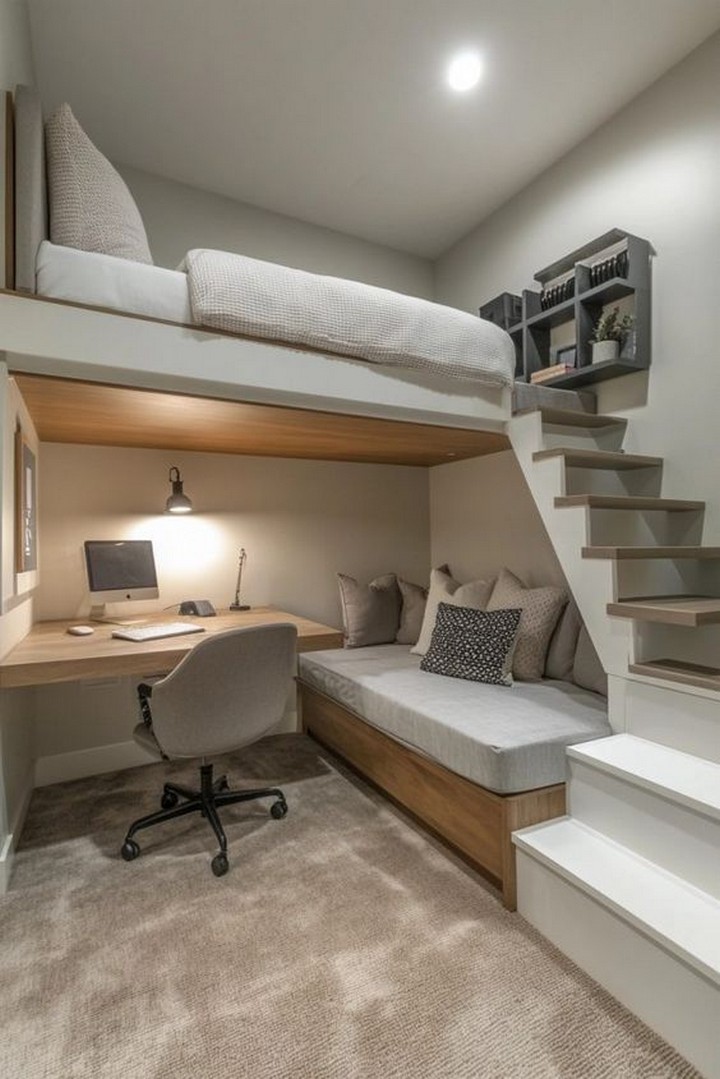
Designing a minimalist small bedroom with space-saving furniture isn’t merely about making do with less space it’s about creating an environment that supports rest, reflection, and rejuvenation without excess. By implementing these 34 ideas selectively based on your specific needs and preferences, you can transform spatial constraints into design opportunities.
The resulting spaces often prove more functional, aesthetically pleasing, and psychologically restful than larger bedrooms filled with conventional furniture and accessories. In embracing the principles of modern minimalism, you may discover that your small bedroom becomes not just a place to sleep but a sanctuary precisely calibrated to your lifestyle.
Have you implemented space-saving solutions in your small bedroom? Which of these ideas resonates most with your needs and aesthetic preferences? Share your experiences or questions in the comments below your insights might be exactly what another reader needs to solve their small-space challenges.
For more inspiration on minimalist living and space-efficient design, explore our related articles on small-space bathrooms, multifunctional living rooms, and decluttering strategies that support the minimalist lifestyle.


